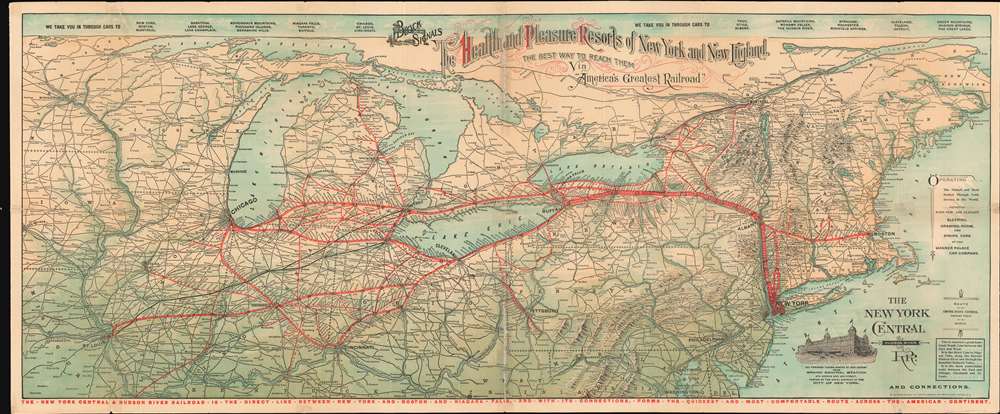This item has been sold, but you can get on the Waitlist to be notified if another example becomes available, or purchase a digital scan.
1898 Matthews Northrup Railroad Map of the Northern United States
HealthPleasure-matthewsnorthrup-1898
Title
1898 (dated) 16.75 x 40.5 in (42.545 x 102.87 cm)
Description
Wellness Tourism in the 19th and early 20th century
The New York Central operated four lines between New York City and Buffalo, allowing the railroad to run several trains a day through the Hudson Valley. Cities in the late 19th century were not clean places. Diseases, such as tuberculosis (also known as the White Plague), ran rampant, and frequent cholera epidemics stoked fear in New York before the construction of the Croton Aqueduct. With this map, the New York Central hoped to entice those New Yorkers capable of visiting Hudson River sanatoria to do so and to use the New York Central to get there. Sanatoria in the United States, now synonymous with insane asylums, were once posh resorts for those seeking to improve their health. Sanatoria were created as sanctuaries for wealthy tuberculosis patients. At the time, tuberculosis was misunderstood, seen as highly infectious, and believed to be almost always fatal. Typical hospitals, particularly in major cities, would turn away tuberculosis patients, fearing that they would infect all the other patients. Out of this fear arose the idea of creating places far away from society for tuberculosis patients to rest and recover. From here, other what we would call wellness resorts today began to appear and purportedly treated everything from skin conditions to anxiety. Many 'patients' at these resorts were not sick at all but were simply seeking time away from the dirt and grime of 19th-century cities.The Russian Flu Pandemic of 1889 - 1890
As stated above, diseases could decimate cities before the advent of modern antibiotics. Although, given the current coronavirus pandemic, we have all learned how a virus can change daily life in unexpected ways. A terribly similar event took place between 1889 and 1890, but a yet-unidentified flu virus caused this pandemic. Known as the 'Russian flu' pandemic, about one million people died worldwide, and recurrences happened through early 1895. Since sanatoria were recognized sanctuaries for the ill at the time, many wealthy individuals in New York City would likely have fled to the Hudson River resorts suggested at here in the hope of avoiding contracting the flu and possible death.Publication History and Census
This map was created by the Matthews-Northrup company and published for the New York Central and Hudson River Railroad in 1898. Several different editions of this map were published, all of which are scarce today. The OCLC does not catalog the 1898 edition and catalogs only three examples of the 1893 edition, which are part of the collections at the Library of Congress, Pennsylvania State University, and Marietta College.CartographerS
Matthews-Northrup Works (fl. c. 1895 - 1930) were a Buffalo, New York based, in their own words, "writing, designing, engraving, printing, [and] binding" firm. The firm was founded by James Newson Matthews (November 21, 1828 - December 20, 1888) as the J. N. Matthews Company. William Phelps Northrup (April 2, 1850 - February 2, 1929) later joined the company as an apprentice and then partner, at which point the firm was reincorporated as the Matthews-Northrup Works. The Matthews-Northrup Works rose to prominence as publishers and printers of railroad maps, with dozens to their credit. When James died, his shares were inhered by George Edward Matthews (1855 - 1910), who ran the business until his death in 1910. Also in 1910, they famously redesigned the cover of National Geographic Magazine. Despite some six previous cover changes in just 21 years, the Matthews-Northrup layout proved so popular that it was used for nearly 50 years. The firm can also take credit for the Winchell typeface, designed in 1903 under E. E. Winchell's tenure as art director. Curiously, the partners of Matthews-Northrup maintained an unusual affectation in which only the officers of the company could wear beards or mustaches. In this same spirit, the firm also had its own private social club, the Fellowcraft Club, where the all-male employees could relax, play pool, drink and dine. Matthews-Northrup maintained offices on Washington Street, Buffalo, where they were based, as well as Madison Square, New York City, Garden Tower, Boston, and the Citizens Building in Cleveland. More by this mapmaker...
George E. Matthews (March 17, 1855 - June 11, 1911) was an American businessman who was the president of the J.N. Matthews Company. Born in Westfield, New York, Matthews and his family moved to Buffalo in his youth. His father, James N. Matthews, bought the Buffalo Express)in 1878, a year after Matthews graduated from Yale University. Matthews began working at the paper as a clerk, but eventually climbed the ladder to become the business manager. He ultimately became the treasurer of the Matthews-Northrup Co., printers and publishers of the Express, of which his father was the sole owner. The firm George E. Matthews and Co. became the owners of the Express following his father's death in 1888, and three years later it was consolidated with the Matthews-Northrup Works to become the J.N. Matthews Co., of which Matthews served as president. Mattews married Mary Elizabeth Burrows on July 12, 1887, with whom he had three children. Learn More...

